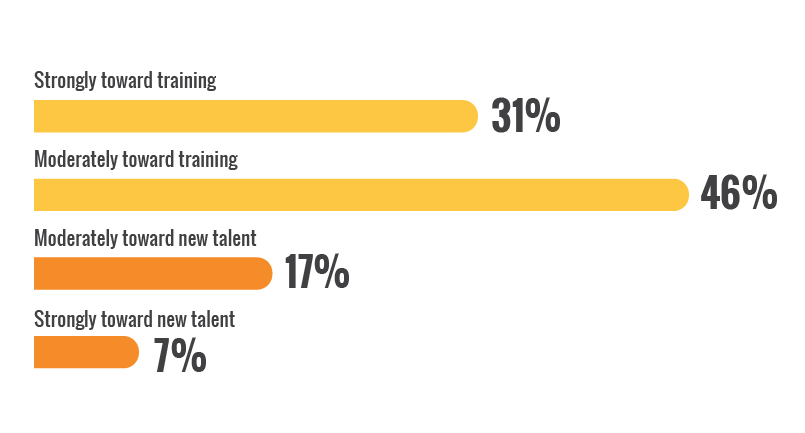Employee value is more than offering health benefits and retirement programs. While employees still value essential employer benefits, companies lately have found themselves improving their perks to remain competitive and retain employees. And what do employees want, overall? Professional development.
What is Employee Development?
Employee development is a strategy for an organization’s growth, productivity and ability to retain valuable employees. According to Deloitte’s 2019 Global Human Capital Trends Survey, people rate the “opportunity to learn as among their top reasons for taking a job.”
Employee Development vs. Career Development
While employee development refers to a company’s efforts to train someone so they perform to the best of their ability, career development is a more personalized effort to help employees obtain their benefits like pay raises, promotions and career changes. The goal behind any employee development initiative will always be to develop leaders internally rather than providing general skills that could be applied at any other job.
Do companies develop employees for their gain? Essentially, yes. The moment people are hired, companies have already chosen to invest in them. HR has to ensure that the employee doesn’t become stagnant and can learn to apply improved skills at work and maximize productivity for the company.
Why is Employee Development Important?
The talent pool prioritizes professional development over most corporate benefits because most of them are concerned about having to improve their skills to match technological advancements and stay ahead of a tight labor market.
According to Deloitte’s report, bridging the skills gap has never been so important. Other than fostering skills growth, employee development also allows employees to embrace their work as an achievement, rather than an operational task.
Moreover, LinkedIn’s 2019 Workforce Learning Report found that 93% of employees would stay at a company longer if it invested in their careers. The report, as well as Deloitte’s, means one thing: today’s workplace expects development. It isn’t merely an option.
Steps to Employee Development
For employee development training to be practical, it must be purposeful and intentional. Curtis Curry, a Florida Tech lecturer and a fellow of the Institute for Cross-Cultural Management (ICCM), explains that HR departments should follow four steps before creating development training at an organization:
- Create a training needs analysis (TNA) and determine if training is the best solution for a performance gap.
- Design practical training and identify organizational constraints and measurable objectives.
- Evaluate training based on collected data.
- Execute a training method based on the steps above.
6 Types of Employee Development
Although most development strategies will vary per company, they align with the idea of supporting business functions, creating value and focusing on employee knowledge, skills, attitudes and behaviors (KSAB). These approaches will vary in scope, time and difficulty but can be a starting point for new training initiatives based on factors like shifting work trends.
Six examples of training methods used by human resource professionals and training and development managers include:
- 360-degree multi-rater feedback: This approach consists of a one-on-one with an employee and a discussion of their year-round execution. In this activity, managers and employees identify performance gaps and close them by coming up with specific action items.
- Experiential learning: Projects linked to the community and even to family life can not only help employees and leaders improve the required skills in the workplace, but also feel more inspired to impact their organization. Some examples include volunteer work and educational initiatives like presenting at a local school.
- Feedback-intensive programs and workshops: Most workshops are developed to enhance soft and hard skills. The program’s topics can cover activities from emotional intelligence to learning new technologies to improve efficiency.
- Action learning projects: These projects offer employees the opportunity to tackle pressing organizational needs. For example, if a specific team needs to reach a target by the end of the year, their leaders can design highly focused training sessions that help them come up with a project plan and get closer to their end goal.
- Mentoring: This approach is most effective when more experienced employees work with newer ones. Having a mentor is useful and can sometimes do more for an employee than any other approach.
- Simulations: This approach helps people develop problem-solving skills and learn to collaborate with others as part of a work-team effort. According to Curry, employee engagement and professional competition can also arise during the completion of simulations.
Not all learning and development strategies work for every industry. Professionals that focus on developing these initiatives must learn what sets each sector and organization apart and measure the effectiveness of the models. For example, the best approach for training a small marketing team on a new software could be collaborative workshops rather than individual tutorials.
How Can Employee Development Be Improved?
When it comes to determining what type of training and development approach is effective for a department, professionals in the field of development should be paying attention to the organization’s mission, work culture, as well as which employee competencies need improvement. Learning and development teams or trainers should make sure that they’re keeping up with best practices to ensure that that, at the end of training, an employee can not only bring value to the company, but enjoy doing it in the process.
Related Readings
Training and Development Specialist Career and Salary Profile
Best Practices for One-on-One’s
8 Ways to Retain Top Employees




